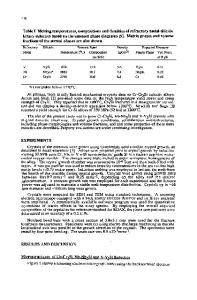Microstructures and thermoelectric power of the higher manganese silicide alloys
- PDF / 4,454,286 Bytes
- 6 Pages / 595 x 842 pts (A4) Page_size
- 79 Downloads / 321 Views
Microstructures and thermoelectric power of the higher manganese silicide alloys Kimiko Kakubo*, Yoshisato Kimura and Yoshinao Mishima Tokyo Institute of Technology, Department of Materials Science and Engineering, 4259 Nagatsuta, Midori-ku, Yokohama 226-8502, Japan, [email protected],*Graduate Student. ABSTRACT In the present work, we investigate microstructures and thermoelectric power of the binary higher manganese silicide (hereafter denoted as HMS) base alloys prepared by ingot metallurgy, i.e., arc-melting in an Ar gas atmosphere. Alloys with 63.5, 64.0 and 64.5 at% Si have a small amount of second phase, either the primary metallic MnSi phase or Si solid solution (hereafter denoted as (Si)). A slight revision is thereby made on the HMS single phase region of the Mn-Si binary phase diagram. The presence of MnSi seems to reduce the thermoelectric power of the HMS, while that of (Si) enhances it. An alloy having the HMS/(Si) eutectic microstructure, 67.9at%Si, shows the highest thermoelectric power in the Mn-Si binary alloys examined. Moreover, effect of doping the p-type elements, Fe and Cr, on the thermoelectric power and microstructural features is also investigated for a 63.5at%Si alloy which consists mostly of HMS phase with a small amount of (Si) phase. It is shown that both elements, especially 0.5 at% Cr addition, enhance the thermoelectric power of the alloys. INTRODUCTION Several transition-metal silicides exhibit relatively high thermoelectric power and are candidate materials for thermoelectric generation at high temperatures because of their excellent oxidation resistance. A compound in the binary Mn-Si system called higher manganese silicide (hereafter denoted as HMS) is known as a p-type thermoelectric material that can be used at high temperatures such as 1000K without any special protection against oxidation[1]. Low cost of constituent elements would be an advantage in commercial use since we are interested in the application of this material as a component of micro gas turbine engine based co-generators. The Mn-Si binary phase diagram in the literature is shown in Fig.1[2], according to which the HMS is a line compound having a complicated ordered crystal structure and its chemical composition as expressed as Mn:Si is reported to range from 1:1.71 to 1:1.75 [3]. It is
N2.9.1
slightly Mn-rich side of the composition for MnSi2 by which reason it is called as HMS. At Si-poor side of the HMS, neighboring two phase region involves a metallic MnSi phase, while at Si-rich side, it involves the primary solid solution of Si phase, hereafter denoted as (Si). In this work, microstructure and thermoelectric power of the binary Mn-Si alloys are first investigated with various silicon concentration of both Si-poor and –rich sides of the HMS. The major interests include whether the single phase HMS can be obtained or not, effects of microstructure and Si concentration on the thermoelectric power of two-phase alloys based on HMS on both sides of it, and the effect of doping ternary elements on the
Data Loading...










